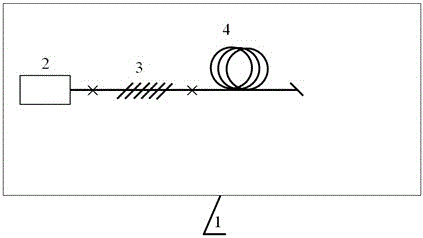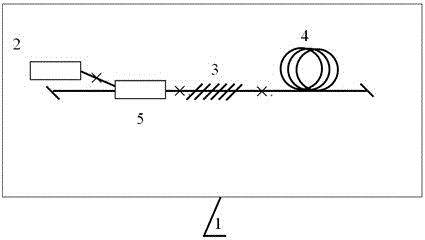High-power random fiber laser based on inclined fiber grating
A technology of tilted fiber gratings and fiber lasers, applied in lasers, laser components, phonon exciters, etc., can solve the problem of low threshold of high-order Raman light, limiting laser output power and efficiency, reducing laser light-to-light conversion efficiency, etc. problem, to achieve the effect of advanced practicality and high power output
- Summary
- Abstract
- Description
- Claims
- Application Information
AI Technical Summary
Problems solved by technology
Method used
Image
Examples
specific Embodiment
[0018] for figure 1 In the high-power random fiber laser shown, the pump source (2) is an ytterbium-doped fiber laser, the center wavelength of the output laser is 1070nm, the output power is 1000 watts, and the 10dB linewidth is 5nm. The output fiber of the pump source (2) is a double-clad fiber with a core diameter of 20 μm and a numerical aperture of 0.06; after passing through the inclined fiber grating (3), the 1070nm laser is about 980 watts (generally considering about 2% loss ), the operating wavelength of the inclined fiber grating (3) is 1178nm, and the 10dB linewidth is 6nm; the length of the passive optical fiber (4) is 500 meters, the transmission loss is 0.3dB / km, the core diameter is 20 μm, and the numerical aperture is 0.06, The output end is cut at an 8 degree bevel. Through the random distributed feedback provided by the weak Rayleigh scattering in the passive fiber and the gain provided by the stimulated Raman scattering, the first-order Raman light output ...
PUM
 Login to View More
Login to View More Abstract
Description
Claims
Application Information
 Login to View More
Login to View More - R&D
- Intellectual Property
- Life Sciences
- Materials
- Tech Scout
- Unparalleled Data Quality
- Higher Quality Content
- 60% Fewer Hallucinations
Browse by: Latest US Patents, China's latest patents, Technical Efficacy Thesaurus, Application Domain, Technology Topic, Popular Technical Reports.
© 2025 PatSnap. All rights reserved.Legal|Privacy policy|Modern Slavery Act Transparency Statement|Sitemap|About US| Contact US: help@patsnap.com


